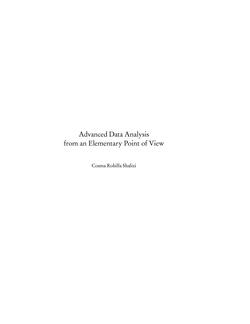
Advanced Data Analysis from an Elementary Point of View
A textbook on data analysis methods, intended for a one-semester course for advance undergraduate students who have already taken classes in probability, mathematical statistics, and linear regression.
Tag(s): Probability Statistics
Publication date: 18 Apr 2016
ISBN-10: n/a
ISBN-13: n/a
Paperback: 856 pages
Views: 12,137
Advanced Data Analysis from an Elementary Point of View
 A textbook on data analysis methods, intended for a one-semester course for advance undergraduate students who have already taken classes in probability, mathematical statistics, and linear regression.
A textbook on data analysis methods, intended for a one-semester course for advance undergraduate students who have already taken classes in probability, mathematical statistics, and linear regression.
Publication date: 18 Apr 2016
ISBN-10: n/a
ISBN-13: n/a
Paperback: 856 pages
Views: 12,137
Document Type: N/A
Publisher: Cambridge University Press
License: n/a
Post time: 29 Jun 2016 04:12:12
This is a draft textbook on data analysis methods, intended for a one-semester course for advance undergraduate students who have already taken classes in probability, mathematical statistics, and linear regression. It began as the lecture notes for 36-402 at Carnegie Mellon University.
This book began as the notes for 36-402, Advanced Data Analysis, at Carnegie Mellon University. This is the methodological capstone of the core statistics sequence taken by our undergraduate majors (usually in their third year), and by undergraduate students from a range of other departments. By this point, students have taken classes in introductory statistics and data analysis, probability theory, mathematical statistics, and modern linear regression. This book does not presume that you once learned but have forgotten the material from the pre-requisites; it presumes that you know that material and can go beyond it. The book also presumes a firm grasp on linear algebra and multivariable calculus, and that you can read and write simple functions in R. If you are lacking in any of these areas, now would be an excellent time to leave.
Tweet
About The Author(s)
Cosma Shalizi is an Associate Professor in the Statistics Department at Carnegie Mellon University. Shalizi is co-author of the CSSR algorithm, which exploits entropy properties to efficiently extract Markov Models from time-series data without assuming a parametric form for the model.

Cosma Shalizi is an Associate Professor in the Statistics Department at Carnegie Mellon University. Shalizi is co-author of the CSSR algorithm, which exploits entropy properties to efficiently extract Markov Models from time-series data without assuming a parametric form for the model.